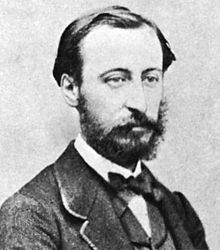4th piano concerto (Saint-Saëns)
The 4th Piano Concerto in C minor , Op. 44 , is a work for piano and orchestra by the French composer Camille Saint-Saëns .
Emergence
The fourth piano concerto was written in 1875, about seven years after the previous third piano concerto . The work is more mature and compositionally advanced in comparison to the previous concerto. Saint-Saëns experimentally uses a two-movement form, which, however, consists of five characteristically different parts. The concept of the concert consists in the versatile processing and alteration of a basic motif that comes from a French song. For this, the composer abandons the classical sonata form . As is usually the case with the 2nd Piano Concerto (G minor), this expressive work is in a minor key.
The piece is dedicated to the concert pianist Anton Door .
To the music
occupation
Solo piano , 2 flutes , 2 oboes , 2 clarinets , 2 bassoons , 2 horns , 2 trumpets , 3 trombones , timpani and strings
1st movement: Allegro moderato - Andante
The first section of the work contains the first two parts of the five-part concept. The theme and original motif (see sheet music example) of the entire concert is introduced by the strings at the beginning of the movement in the Allegro . It is a French song arranged by the composer. The orchestra and the ever more virtuoso piano solo develop the theme in a dialogue. It finally sounds fortissimo in majestic C minor, before it is jokingly modified with erratic runs by the woodwinds and piano. Instead of sonata form Saint-Saens applies the composition technique of variation and processing, so that the whole concert figuratively as implementation of Urmotivs could be considered.
A transitional section, consisting of chords broken up into arpeggios , leads to a lyrical variant of the song. This represents the second part of the concert and thus the andante part of the first movement. The piano performed is then played around by the romantic-elegiac piano. In the fifth part of the concert, this lyrical form of the theme is taken up again and majestically enhanced. It experiences a first increase afterwards, as it is adorned with virtuosity by the solo piano and large-fingered chords. Soft brass fanfares in the background of the increasingly restless musical events create a build-up of tension, which, however, is no longer resolved at the end of the first movement.
2nd movement: Allegro vivace - Andante - Allegro
The second section comprises parts 3 to 5 of the concert, beginning with an Allegro part that begins with jokingly flickering sequences in the piano and the woodwinds. It takes on the function of a Scherzo sentence . The original motif of the concert now appears in a rhythmically changed, erratic variant in the orchestra, jokingly played around by the piano before it takes up the theme itself. A child-like, simple-looking motif appears in the piano, consisting of tone sequences developed from the original motif, which are played with up to six tone repetitions ( primes executed in quick succession ) per note. The orchestra responds with short interjections in a counter-rhythm.
The following Andante part , which is of opposite character, begins with threatening motifs in the strings. In the flutes, however, the lyrical and vocal versions of the main theme reappear. A sudden virtuoso outburst of the piano leads to the concluding part of the concert with trumpet fanfares.
In the last Allegro part of the work, the piano represents the lyrical and very vocal development of the theme material in an initially monophonic form. The origin of the theme as a song can hardly be misunderstood here. The following apotheosis now grips the whole orchestra. Again and again played around by the solo instrument, the song theme is further processed, whereby the joyful and optimistic style is always retained. The old C minor at the beginning of the concert has turned into a radiant C major. The concert ends with this character in a great and all-stirring coda , in which the jubilant song is finally heard in the brass section.
effect
Saint-Saëns' special conceptual and motivic work in this work represents a high point of his work. The first performance of the work in 1875 with the composer as a soloist was a great success. A few years later, the French composer Gabriel Fauré created an arrangement of the concerto for two pianos. The concert is still very popular today and is performed very frequently. It is considered to be one of the strongest works by Saint-Saëns, which, through its innovation, is able to refute the accusation of the Frenchman's backward compositional style, which is sometimes expressed.
Web links
- Piano Concerto No.4, Op.44 (Saint-Saëns, Camille) : Sheet music and audio files in the International Music Score Library Project
- Summary of Saint-Saëns' piano concertos ( Memento from May 28, 2014 in the Internet Archive )
